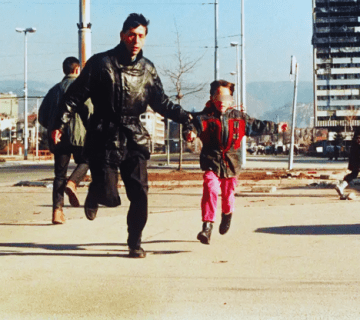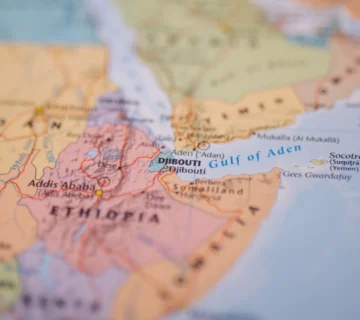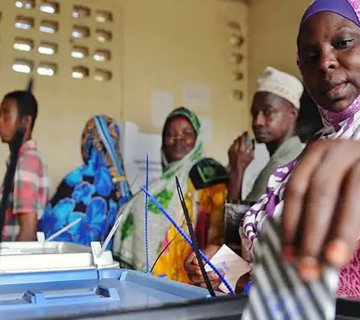Executive Summary
Kenya’s renewed bid for the African Union Commission (AUC) chairmanship through the candidacy of opposition leader Raila Odinga, has set the Kenyan government on the limelight once again, owing to intensive lobbying across the continent. The AUC chair is a crucial position tasked with overseeing the African Union Commission’s operations and shaping its policies. This paper delves into Kenya’s past strategies while unveiling the new approaches being employed in its renewed pursuit of the position. Odinga’s manifesto is briefly analyzed. The paper emphasizes the importance of strategic diplomacy and leveraging the SADC bloc among other strategies. Challenges to Odinga’s candidacy, including his age and the dynamics within regional alliances, are discussed, along with recommendations for strengthening Kenya’s position
Introduction
The African Union Commission (AUC) chair, a position that Kenya’s former Foreign Affairs Cabinet Secretary Amina Mohammed once vied for in 2017, is once again attracting regional attention and sparking lively discussions in the country in the wake of President William Ruto’s endorsement of Kenya’s opposition leader, Raila Odinga, for the position . The AUC chair is the head of the commission, which is the secretariat of the African Union (AU), an organ tasked with running the union’s day to day operations. Duties of the chair range from administration of the commission, and representation to promotion of the union’s interests within and outside the continent. Generally, the chairperson plays a pivotal role in shaping the policies and direction of the AU alongside representing the interests of the member states on the global stage.
The AUC chair is elected by the AU Assembly (comprises of heads of state and government) for a four-year term, which is renewable once. Election of the chair is done alongside that of the deputy and is achieved through a two-thirds majority consensus of member states. Since the reconstitution of the AU in 2002, representatives from the Western, Southern and Central Africa regions have respectively served in the position of chair. Owing to the AU’s principle of regional rotation, the next chair is scheduled to come from the Eastern Africa region.
Kenya’s previous bid for the position
In 2017, Amina’s candidacy was perceived as a strong one considering her credentials, which included serving in various departments in the Ministry of foreign affairs as director, Permanent Representative to the UN (2000-2006), chair of the World Trade Organization’s General Council (2005) and ultimately Kenya’s Cabinet Secretary for Foreign Affairs (2013-2018). In light of her aforementioned impressive credentials, Kenya embarked on a continental mission of promoting her as the ideal candidate for the position. Kenya’s campaign strategy was multifaceted, involving in-person high-level diplomatic engagements accompanied by leveraging on regional bodies and alliances. The multifaceted approach drew Ksh 437.7 million from the exchequer in Kenya, a figure that was Ksh 50 million more than the amount budgeted for the campaign.
Despite Amina’s impressive credentials and the large sum of money spent towards the campaign, she lost to Chad’s Mahamat Moussa Faki. Moussa Faki served as Chad’s Prime Minister (2003-2005), Minister for Foreign Affairs (2008-2017), chair of the AU Peace and Security Council (September 2013) and chair of the UN Security Council (December 2015). Prior to his election, Faki had been involved in the formation of AU’s maritime policy, several counter-terrorism initiatives and in the South Sudan Peace process. During the voting period, Amina led by 16 votes against Moussa Faki’s 14 in the first round, with the remaining votes split between other candidates. Due to requirements for a two-third majority for the declaration of a winner, seven more rounds of voting commenced, with trailing candidates requested to bow out of the race. In the seventh and final round, Faki surpassed the two-third threshold by securing 38 votes.
Several factors come into play when analyzing Kenya’s failed bid for the AUC chair position. While the Government of Kenya made the valiant effort of attempting to appoint a task force, this task force was largely perceived as lacking in experience. The taskforce was led by Dr. Fred Matiang’i, then a Minister for Internal Affairs, and composed largely of politicians with limited diplomatic experience. Analysts argue that Kenya’s reliance on politically motivated appointments, rather than experienced foreign service officers or seasoned diplomats, created a disconnect between the country’s diplomatic needs and the personnel selected for the role. This approach contrasted with the norms of other nations, which typically appoint diplomats with extensive experience in foreign relations and diplomacy to handle critical campaigns. (Kenya, 2024). Another significant challenge Kenya faced was insufficient support from the East African Community (EAC), a key regional bloc. After the voting, Amina mentioned that Kenya’s neighbors let her down and that Kenya needed to evaluate its friendships. The statement was perceived to be a response to suspicions that Uganda, Tanzania and Burundi abandoned Kenya during the crucial voting rounds, ultimately costing Kenya’s candidature. As Kenya gears up for the ballot once again, it’s important to practice cautious optimism since internal wrangles that have existed in the EAC overtime may hinder all the partner states from voting along the common resolution to support Kenya’s bid.
Raila Odinga’s Bid and Kenya’s Campaign strategy
Raila Odinga brings in a vast amount of experience into the race especially in governance, a crucial skill needed for the general administration of the commission. Odinga has previously served as a member of parliament, held different ministerial positions and ultimately became the Prime Minister from 2008-2013. The highlighted positions give him an upper hand in offering leadership to the commission. Over the years, Odinga has become a prominent figure in Kenyan politics, emerging as a key opposition leader. Through his leadership, he has consistently championed good governance, accountability, and anti-corruption measures, solidifying his reputation as a statesman dedicated to public service and democratic principles. Despite not holding the presidency, Raila has remained a central figure in Kenyan politics, continuously challenging the ruling governments and advocating for democratic reforms.
Besides domestic politics, Odinga has a background of involvement in continental affairs. In 2018, he was appointed by Moussa Faki as the AU High Representative for Infrastructure and Development, a position he held till 2021. During his tenure as the High representative, he was exposed to the internal operations of the AU and is perceived to have forged connections with various key stakeholders across the continent. Prior to that, the African Union fronted him as the chief mediator for the Ivory Coast 2011 post -election dispute between Laurent Gbagbo and Alassane Ouattara. Although the mediation attempt was unsuccessful, his appointment by the AU signified some level of trust in Raila’s ability to engage in dispute resolution.
In light of Raila’s admirable credentials, overtime experience and lessons learnt from Amina’s failed candidature, Kenya now appears to be keen on crafting an effective campaign strategy that will catapult Raila to the top AU job. Contrary to the 2017 campaign taskforce, President Ruto unveiled a campaign secretariat that is well-versed in diplomacy. The secretariat is led by Kenya’s Foreign Affairs Principal Secretary Korir Sing’oei and former Kenyan Ambassador to the United States of America, Elkanah Odembo. The secretariat comprises of a diverse membership ranging from politicians, technocrats and representatives drawn from the five regions in Africa. That notwithstanding, the President has further promoted Raila among his counterparts through a series of international trips. Between January and August 2024, President Ruto had made trips to over 10 African countries for state visits and other official reasons, with the AUC chair being considered among the key areas of discussion. Besides that, the head of state has utilized key Summit meetings such as the Forum on China Africa Cooperation (FOCAC) and the 77th United Nations General Assembly (UNGA), 23RD COMESA Summit, by holding side meetings aimed at seeking support from various African heads of government.
An Evaluation of Odinga’s Manifesto
The former Prime Minister, who has mainly campaigned as a Pan-Africanist has a manifesto based on eight pillars which rightly capture the continent’s shared aspirations. The eight pillars include; Economic Transformation, Enhancing Intra-African Trade, Financial Independence, Gender Equity, Agricultural Transformation, Climate Action, Peace and Security and Continental Integration. While the manifesto accurately highlights key areas that require action, a concern however is whether Odinga is taking up too much that he could handle by outlining the eight highlighted pillars as priority. The highlighted areas can however serve as a blueprint for Africa’s vision since the areas cannot be addressed within a given tenure.
Raila’s Support from the Region and other African Countries
In a move that is perceived to be a way of strengthening ties that cost its previous AUC chair bid, Kenya hosted various East African leaders during her candidate’s unveiling ceremony. The high-profile ceremony was held on August 27, 2024, at the State House, Nairobi and was attended by EAC leaders such as President Salva Kiir Mayardit (South Sudan), President Samia Suluhu Hassan (Tanzania), President Yoweri Museveni (Ugandan), Prime Minister Gervais Ndirakobuca (Burundi), and State Minister for Foreign Affairs James Kabarebe (Rwanda). Other notable figures present included former Tanzanian President Jakaya Kikwete and former Nigerian President Olusegun Obasanjo. Besides being a symbol of East African unity and support towards one candidate, the meeting provided an opportunity for dialogue on Raila’s candidacy.
Besides the EAC, Odinga has been able to receive official endorsements from Malawi, Zambia, Zimbabwe, Angola, Equatorial Guinea, Togo, Ghana, Mauritius, Guinea Bissau, Gambia Algeria and Senegal. When tallied alongside the EAC member states endorsements, Mr. Odinga’s prospective vote tally stands at 20. Based on endorsements, Mr. Odinga has a narrow lead. It is important to note that the winner of the AUC Chairperson election will not require the usual 37 votes needed for a two-thirds majority. This is because six countries (Sudan, Mali, Niger, Guinea, Burkina Faso, and Gabon) have been suspended from the African Union (AU) due to unconstitutional changes in government. As a result, the total number of eligible voters is reduced to 49. Therefore, to secure the two-thirds majority, the winning candidate will need 33 votes out of the 49 remaining eligible votes.
Challenges to Odinga’s candidature
While Odinga’s extensive experience that he has accrued overtime is an asset, his age, currently 79, might present a challenge. Given that nearly 70 percent of the continent’s population is below 30 years of age, a leadership perceived as less representative of the youth may face challenges in gaining widespread legitimacy after election. This is particularly relevant in the context of recent youth-led protests across various regions, especially in Kenya, calling for change in the status quo.
What can Kenya do to strengthen its Candidature?
As it employs other strategies, Kenya needs to heavily leverage on regional blocs and alliances. The secretariat’s decision to host the EAC leaders was an applaudable decision as it sought to strengthen ties within the EAC. Besides the EAC, the SADC-bloc is especially a key player in ensuring the success of Kenya’s candidature. Being a pre-dominantly anglophone bloc, the latter is traditionally expected to vote along Kenya. The same is the case for Francophone countries that traditionally vote in favor their fellow Francophones, which in this case is Djibouti. The expected vote from the Francophone bloc may however reduce to Kenya’s advantage owing to the suspension of four Francophone countries (Mali, Guinea, Gabon and Burkina Faso) from the union.
Over time, SADC-countries have demonstrated a tendency of having a firm collective position, when compared to other regional blocs in the continent. Notable examples include their collective abstinence from the AUC chair vote in 2017 and the collective position on the readmission of Morocco into the AU. During the last AUC elections, as voting rounds progressed, member-states from the SADC bloc boycotted the vote, as a way of standing in solidarity with their candidate who had lost in the preliminary voting rounds. Besides the AUC elections, the bloc depicted its solidarity by voting against Morocco’s readmission into the AU in 2017. Out of the 55-member states, 39 voted in favor of Morocco’s readmission, the remaining member states that voted against were predominantly from the SADC-bloc, led by South Africa that has consistently supported the self-independence of the Sahrawi Arab Democratic Republic. The latter demonstrated the influence that South Africa, an anchor state in the Southern region, had towards the vote.
South Africa’s support for Kenya, can therefore go a long way in helping the latter in gaining regional influence and diplomatic backing in the Southern Africa region. So far, Kenya has received endorsements from South Africa, Malawi, Zambia, Tanzania and Zimbabwe within the SADC region. Kenya could therefore leverage on its backing from South Africa, to gain more votes in the Southern Africa region.
Other recommendations for Kenya include;
- Odinga should revise the priority areas outlined in his manifesto and reduce them to few feasible ones. He should afterwards consider actionable strategies for how he will achieve his revised priority areas.
- Kenya should consider having a robust fallback strategy to ensure continued support in case multiple voting rounds are required. This approach is crucial because prolonged voting rounds can demand extensive diplomatic effort and consistent lobbying.
- Kenya should continue to leverage high-level bilateral engagements as it has done and persist in seeking the support of individual states. Whether or not it secures backing from anchor states such as South Africa or Nigeria, Kenya must prioritize direct engagement with other nations to build its support base. Regional blocs, particularly those with large memberships, often experience divergence in their resolutions, as seen with the OIC. Kenya can strategically exploit this dynamic by pursuing independent alliances and securing endorsements outside of these blocs.
- Kenya should prioritize engaging key stakeholder groups across the continent to build broad-based support. This includes actively involving African youth and civil society, whose influence in shaping policy discourses continues to grow. By highlighting how Kenya’s leadership could address issues such as youth unemployment, education, and innovation, Kenya can demonstrate its commitment to the aspirations of the continent’s majority demographic. Additionally, highlighting policies that promote gender equity and inclusivity that aligns with the African Union’s Agenda 2063 and resonates with diverse stakeholders.
Conclusion
Kenya’s pursuit of the African Union Commission chairmanship, through the candidacy of Raila Odinga, reflects a significant shift in both strategy and regional diplomacy. While the failure of Kenya’s previous bid in 2017, through the candidacy of Amina Mohammed, was marred by internal challenges and insufficient regional support, the current campaign has been marked by a more inclusive and diplomatic approach. On the other hand, Mr. Odinga’s extensive experience, both in domestic politics and continental affairs positions him as a strong contender for the role. Odinga’s candidacy is however not without its challenges. Regional competition, particularly from Djibouti’s Mohamoud Youssouf, and the internal dynamics of the East African Community remain significant obstacles. As the election approaches, Kenya’s diplomatic efforts will determine whether it can turn the lessons of the past into a pathway to victory, securing a leadership role that shapes the future of the African Union and enhances Kenya’s position on the continental and global stage.
Photo Credits:TV47 Kenya
Jeremy Oronje and Bravin Onditi are Researchers at the HORN Institute



